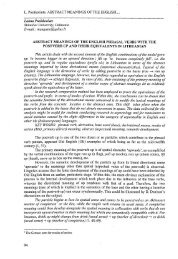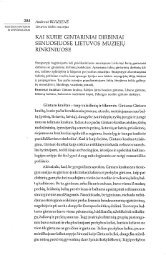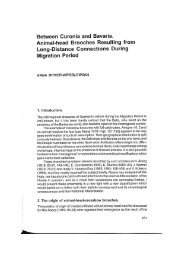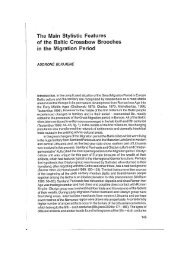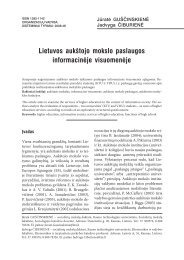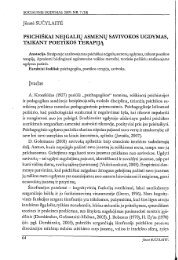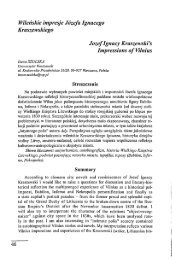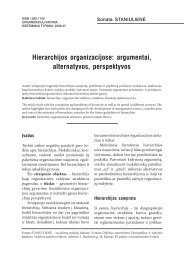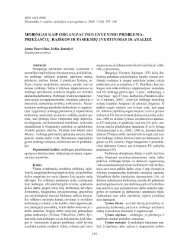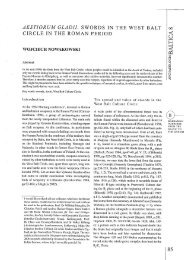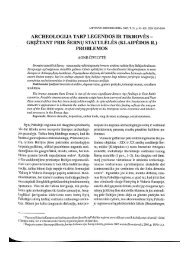ECO-MARKETING AND ECO-LABELLING: DOES IT ENSURE ...
ECO-MARKETING AND ECO-LABELLING: DOES IT ENSURE ...
ECO-MARKETING AND ECO-LABELLING: DOES IT ENSURE ...
You also want an ePaper? Increase the reach of your titles
YUMPU automatically turns print PDFs into web optimized ePapers that Google loves.
D.Grundey \65 ISSN 1648-4460<br />
5.5 Analysis of Eco-labels in Europe (and Rest of the World)<br />
Researching Customer Loyalty in Lithuania<br />
The objective of this paper is to discuss the advantages and limitations of different<br />
kinds of eco labels in Europe within the framework of ecological modernisation.<br />
Within an integrated product policy (IPP) environmental product informadon is one<br />
important tool (Rubik, 2003a). In the business to consumer dialogue, eco-labels are a central<br />
part of "transmitting environmental information" (Gmndey, 2003). Other consumer oriented<br />
information channels are test reports and test notes from consumer organisations and test<br />
institutions, quantitative product information from producers on the package or information<br />
through internet, personal sales talks and advertising.<br />
Eco-labels include various symbols, schemes, and institutional and legal<br />
arrangements. We can distinguish between mandatory and voluntary labels in the following<br />
way (Rubik, 2003b):<br />
• Mandatory labels like the EU energy label, relevant for household appliances and<br />
mandatory labels for chemical products.<br />
• ISO-type I eco labels, classical third-party labels like the EU-flower, the German Blue<br />
Angel and the Nordic White Swan.<br />
• ISO-type II eco labels, self-classification by industry or retailers.<br />
• ISO-type III eco labels, quanthative environmental product declarafions (EPD).<br />
• Other relevant labels, including social labels and organic<br />
labels.<br />
greendOt • other not relevant labels, including recycling symbols like<br />
Ô<br />
the green dot'.<br />
The mandatory labels arc based upon EU-directives and are valid<br />
for chemical substances and household appliances in Europe.<br />
3.3.1 ISO-type I labels<br />
The main advantage of ISO-type I labels probably is that they use simple symbols; it<br />
is easy to communicate the message to the consumers. In addition they gain credence by<br />
being scientifically based and organised through a third party control regime. Type I-labcls<br />
seem to work very well for consumables, providing information at the point of sales. Such<br />
labels will typically contain summed up informafion, where expert panels esfimate the relative<br />
importance of various impacts (pollufion, energy etc.), presenting the consumer with the result<br />
of a process, but with free public access to criteria. The average consumer just has to relate to<br />
the symbol. This simple presentation of rather complicated matters seems to have a potential<br />
for being met by high levels of trust from consumers.<br />
Typc-1-labcls' main shortcomings might be that they are national or regional, so far<br />
not a success on a European level. Further, they obviously work better for some types of<br />
products than for others, even with a number of national differences.<br />
Blue Angel" in Germany was the first voluntary ISO-type I label<br />
in the wodd, established in 1978. During the 90tics similar cco-labcls were<br />
' The Dual System operates in conjunction with tltc existing municipal solid waste management structure in Gcmiany.<br />
Consumer product manufacturers pay fees to DSD (Duales System Dculsclitand GmbH) to place its trademark "green dot" on<br />
their packages. This symbol is intended to represent a recycling guarantee, for DSD then collects and sorts the packages<br />
consutncrs have discarded and directs Ihcm to rccydcrs. As long as the ordinance's collecting, sorting, and refilling quotas<br />
arc met, retailers do not have lo "take back" primary packages and consumers do not have to pay high mandated deposits on<br />
non-rcnilablc containers. Packaging waste is collected curb-side in DSD bins or in municipal bins placed around<br />
neighbourhoods for glass and paper.<br />
• The world's first cco-labcling progratn, Uluc Angd, was created in 1977 to promote cnvlrontncntally sound products,<br />
rclali\c lo olhcrs in the same grotip categories, litis cco-labcl relics on infoniialion and \olunlary cooperation, as well as on<br />
(lie motivation and the willingness of each individual lo make a conlribvilion towards environmental protection. The criteria<br />
TR.IiV.f/()lU/.l77().V,V IN nU.SINti.SS d- liCONO.\llCS\ Vol. 8, No I (16), 2009



